coolant reservoir Hyundai H-1 (Grand Starex) 2005 Owner's Manual
[x] Cancel search | Manufacturer: HYUNDAI, Model Year: 2005, Model line: H-1 (Grand Starex), Model: Hyundai H-1 (Grand Starex) 2005Pages: 205, PDF Size: 9.14 MB
Page 127 of 205
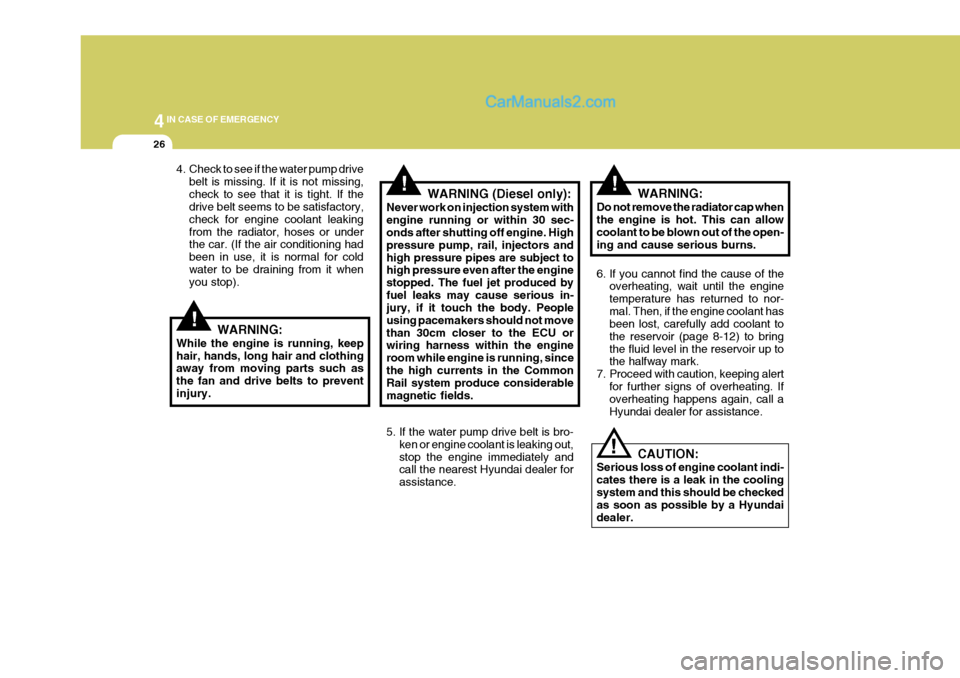
44IN CASE OF EMERGENCY
26
4. Check to see if the water pump drivebelt is missing. If it is not missing, check to see that it is tight. If the drive belt seems to be satisfactory, check for engine coolant leakingfrom the radiator, hoses or under the car. (If the air conditioning had been in use, it is normal for coldwater to be draining from it when you stop).
!WARNING:
While the engine is running, keep hair, hands, long hair and clothing away from moving parts such as the fan and drive belts to preventinjury.
!WARNING (Diesel only):
Never work on injection system with engine running or within 30 sec- onds after shutting off engine. High pressure pump, rail, injectors andhigh pressure pipes are subject to high pressure even after the engine stopped. The fuel jet produced byfuel leaks may cause serious in- jury, if it touch the body. People using pacemakers should not movethan 30cm closer to the ECU or wiring harness within the engine room while engine is running, sincethe high currents in the Common Rail system produce considerable magnetic fields.
5. If the water pump drive belt is bro- ken or engine coolant is leaking out, stop the engine immediately and call the nearest Hyundai dealer for assistance.!WARNING:
Do not remove the radiator cap when the engine is hot. This can allow coolant to be blown out of the open- ing and cause serious burns.
6. If you cannot find the cause of the overheating, wait until the engine temperature has returned to nor-mal. Then, if the engine coolant has been lost, carefully add coolant to the reservoir (page 8-12) to bringthe fluid level in the reservoir up to the halfway mark.
7. Proceed with caution, keeping alert for further signs of overheating. Ifoverheating happens again, call a Hyundai dealer for assistance.
CAUTION:
Serious loss of engine coolant indi-cates there is a leak in the coolingsystem and this should be checked as soon as possible by a Hyundai dealer.
!
Page 157 of 205
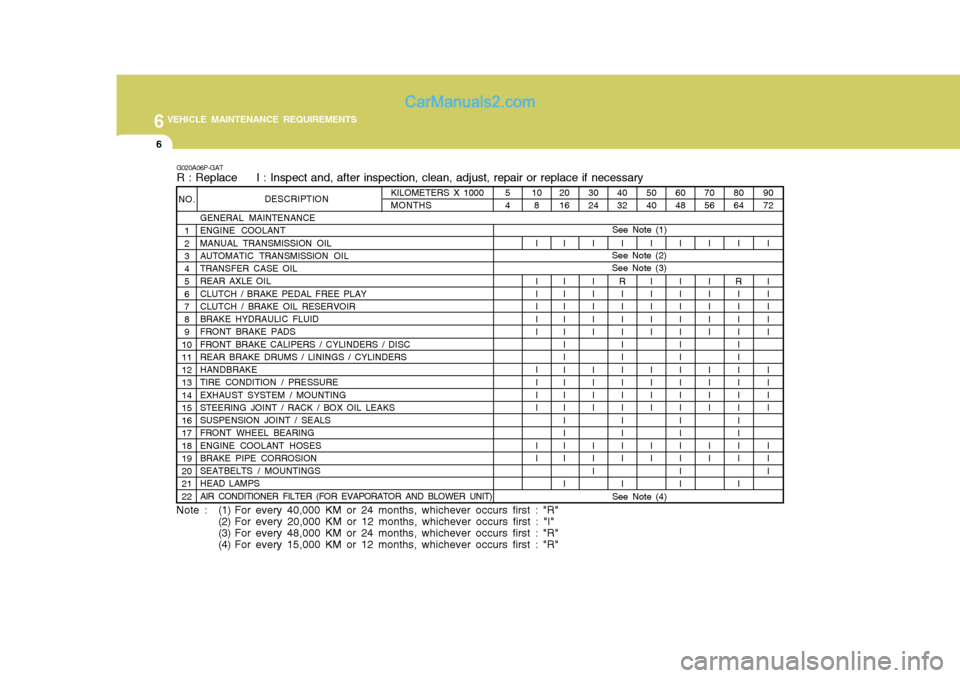
6VEHICLE MAINTENANCE REQUIREMENTS
6
50 40I I I I I I I I I I I I
KILOMETERS X 1000MONTHS
NO.
1 2 3 4 5 6 7 8 9
1011 12 13 14 15 16 17 18 19 20 21 22 DESCRIPTION
GENERAL MAINTENANCE ENGINE COOLANT MANUAL TRANSMISSION OIL AUTOMATIC TRANSMISSION OIL TRANSFER CASE OIL REAR AXLE OIL CLUTCH / BRAKE PEDAL FREE PLAY CLUTCH / BRAKE OIL RESERVOIR BRAKE HYDRAULIC FLUID FRONT BRAKE PADS FRONT BRAKE CALIPERS / CYLINDERS / DISC REAR BRAKE DRUMS / LININGS / CYLINDERS HANDBRAKE TIRE CONDITION / PRESSURE EXHAUST SYSTEM / MOUNTING STEERING JOINT / RACK / BOX OIL LEAKS SUSPENSION JOINT / SEALS FRONT WHEEL BEARING ENGINE COOLANT HOSES BRAKE PIPE CORROSION SEATBELTS / MOUNTINGS HEAD LAMPS AIR CONDITIONER FILTER (FOR EVAPORATOR AND BLOWER UNIT)
G020A06P-GAT R : Replace I : Inspect and, after inspection, clean, adjust, repair or replace if necessary
80 64
I
R II I I I I I I I I I I I I I 90 72
I I I I I I I I I I I I I
70 56
I I I I I I I I I I I I
6048
I I I I I I I I I I I I I I I I I I
4032
I
R II I I I I I I I I I I I I I
30 24
I I I I I I I I I I I I I
20 16
I I I I I I I I I I I I I I I I I108
I I I I I I I I I I I I
5 4
See Note (1)
Note : (1) For every 40,000 KM or 24 months, whichever occurs first : "R" (2) For every 20,000 KM or 12 months, whichever occurs first : "I"
(3) For every 48,000 KM or 24 months, whichever occurs first : "R"
(4) For every 15,000 KM or 12 months, whichever occurs first : "R"
See Note (4)
See Note (2) See Note (3)
Page 161 of 205
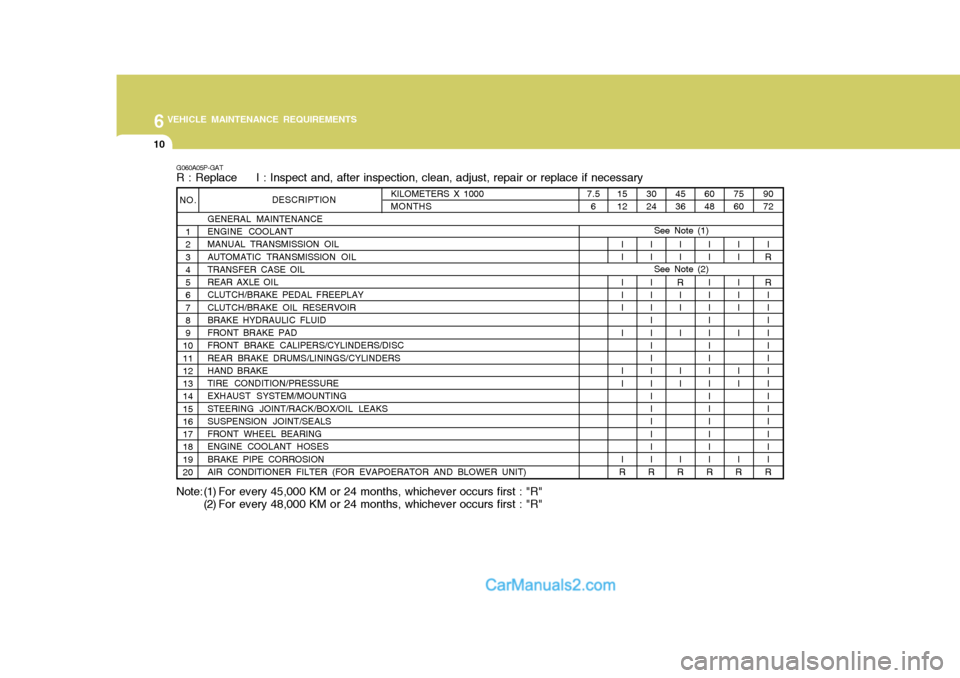
6VEHICLE MAINTENANCE REQUIREMENTS
10
45 36II
R II I I I I
R
15 12
II I I I I I I I
R
G060A05P-GAT R : Replace I : Inspect and, after inspection, clean, adjust, repair or replace if necessary
See Note (2)
KILOMETERS X 1000 MONTHS
NO.
1 2 3 4 5 6 7 8 9
1011 12 13 14 15 16 17 18 19 20 DESCRIPTION
GENERAL MAINTENANCE ENGINE COOLANT MANUAL TRANSMISSION OIL AUTOMATIC TRANSMISSION OIL TRANSFER CASE OIL REAR AXLE OIL CLUTCH/BRAKE PEDAL FREEPLAY CLUTCH/BRAKE OIL RESERVOIR BRAKE HYDRAULIC FLUID FRONT BRAKE PAD FRONT BRAKE CALIPERS/CYLINDERS/DISC REAR BRAKE DRUMS/LININGS/CYLINDERS HAND BRAKE TIRE CONDITION/PRESSURE EXHAUST SYSTEM/MOUNTING STEERING JOINT/RACK/BOX/OIL LEAKS SUSPENSION JOINT/SEALS FRONT WHEEL BEARING ENGINE COOLANT HOSES BRAKE PIPE CORROSION AIR CONDITIONER FILTER (FOR EVAPOERATOR AND BLOWER UNIT)
75 60
II I I I I I I I
R 90 72
I
R R I I I I I I I I I I I I I I
R
6048
II I I I I I I I I I I I I I I I
R
3024
II I I I I I I I I I I I I I I I
R
7.5
6
See Note (1)
Note: (1) For every 45,000 KM or 24 months, whichever occurs first : "R"
(2) For every 48,000 KM or 24 months, whichever occurs first : "R"
Page 170 of 205
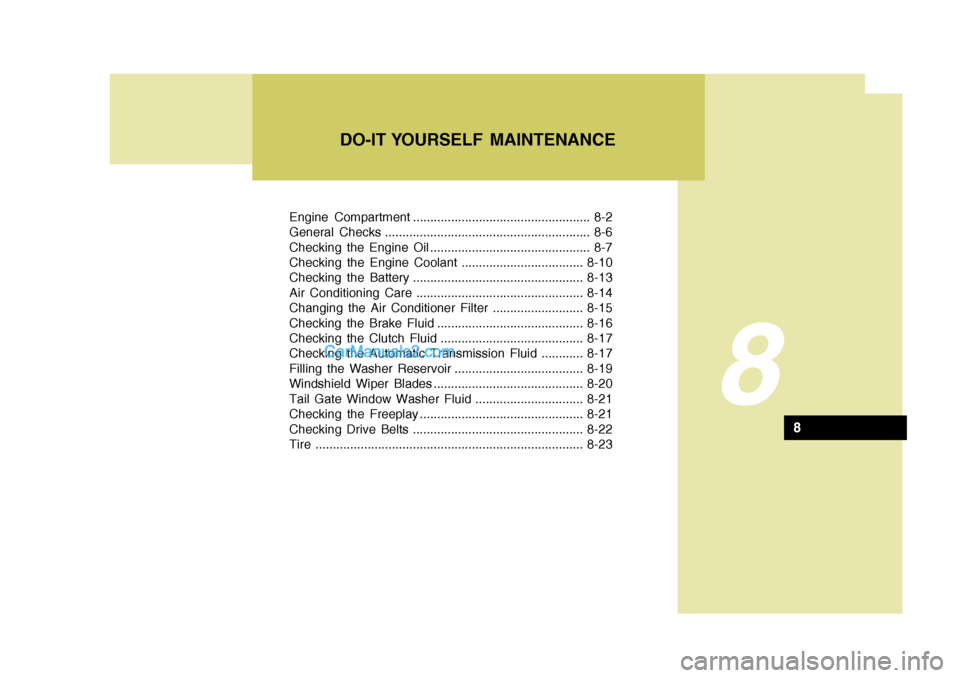
Engine Compartment ................................................... 8-2
General Checks ........................................................... 8-6
Checking the Engine Oil .............................................. 8-7
Checking the Engine Coolant ...................................8-10
Checking the Battery ................................................. 8-13
Air Conditioning Care ................................................ 8-14
Changing the Air Conditioner Filter .......................... 8-15
Checking the Brake Fluid .......................................... 8-16
Checking the Clutch Fluid ......................................... 8-17
Checking the Automatic Transmission Fluid ............ 8-17
Filling the Washer Reservoir ..................................... 8-19
Windshield Wiper Blades ........................................... 8-20
Tail Gate Window Washer Fluid ............................... 8-21
Checking the Freeplay ............................................... 8-21
Checking Drive Belts ................................................. 8-22
Tire ............................................................................. 8-23
8
DO-IT YOURSELF MAINTENANCE
8
Page 171 of 205

8DO-IT YOURSELF MAINTENANCE
2ENGINE COMPARTMENT
1. Windshield washer fluid reservoir cap
2. Engine oil filler cap
3. Engine oil level dipstick
I010A01P-GAT DIESEL ENGINE (2.6 N/A)
4. Brake booster
5. Brake fluid reservoir
6. Radiator cap
7. Air cleaner 8. Power steering fluid reservoir
9. Battery
10.Engine coolant reservoirI010A01P-1
Page 172 of 205
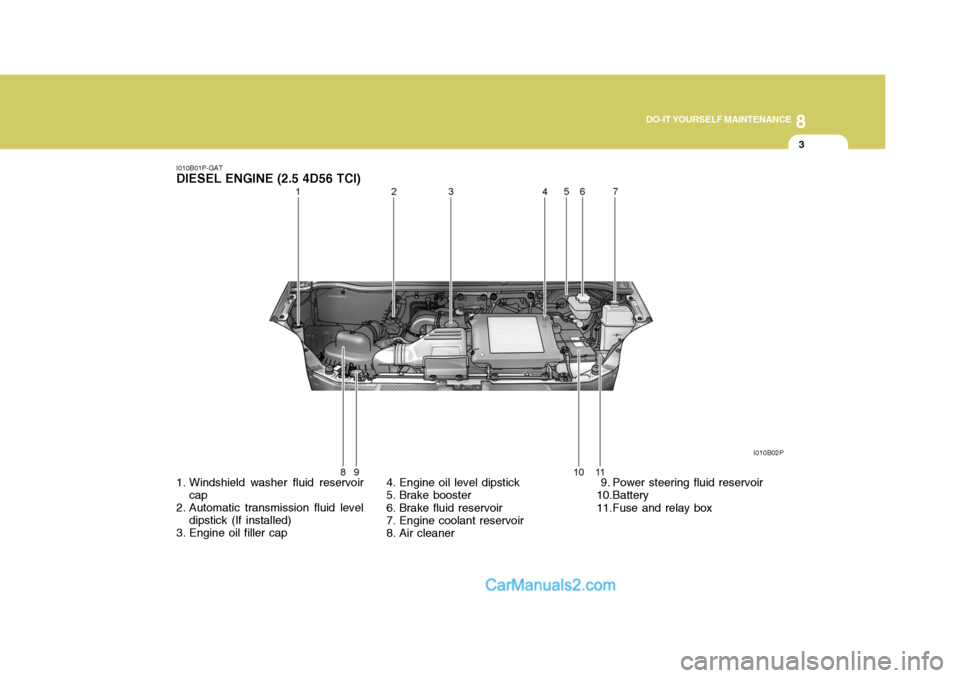
8
DO-IT YOURSELF MAINTENANCE
3
I010B01P-GAT
DIESEL ENGINE (2.5 4D56 TCI)
1. Windshield washer fluid reservoir cap
2. Automatic transmission fluid level dipstick (If installed)
3. Engine oil filler cap 4. Engine oil level dipstick
5. Brake booster
6. Brake fluid reservoir
7. Engine coolant reservoir
8. Air cleaner 9. Power steering fluid reservoir
10.Battery
11.Fuse and relay boxI010B02P
Page 173 of 205
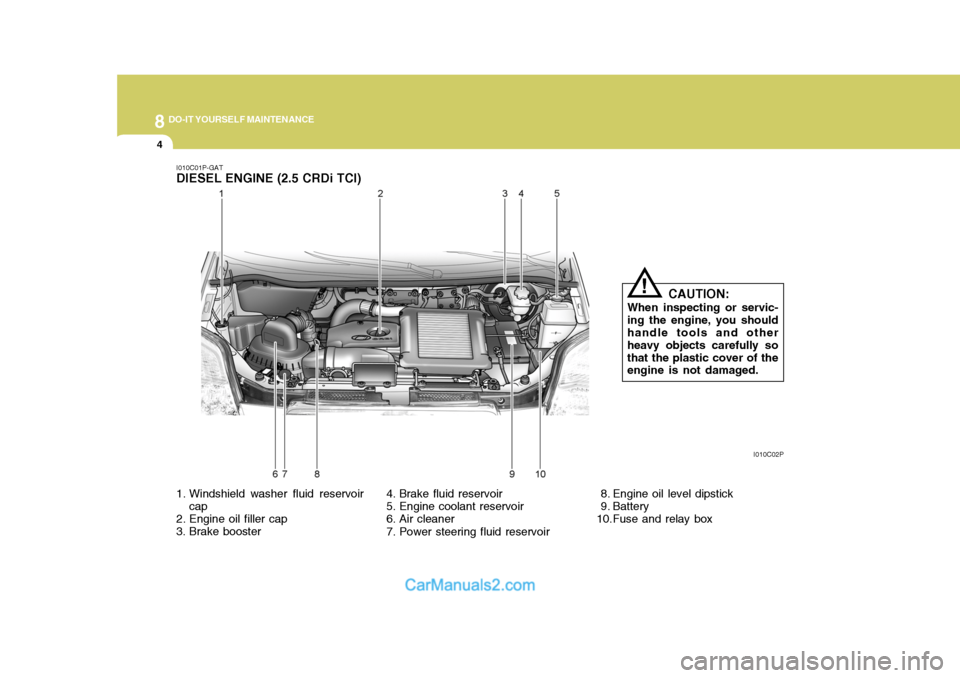
8DO-IT YOURSELF MAINTENANCE
4
I010C01P-GAT DIESEL ENGINE (2.5 CRDi TCI)
1. Windshield washer fluid reservoircap
2. Engine oil filler cap
3. Brake booster 4. Brake fluid reservoir
5. Engine coolant reservoir
6. Air cleaner
7. Power steering fluid reservoir 8. Engine oil level dipstick
9. Battery
10.Fuse and relay boxI010C02P
CAUTION:
When inspecting or servic-ing the engine, you should handle tools and other heavy objects carefully sothat the plastic cover of the engine is not damaged.
!
Page 180 of 205
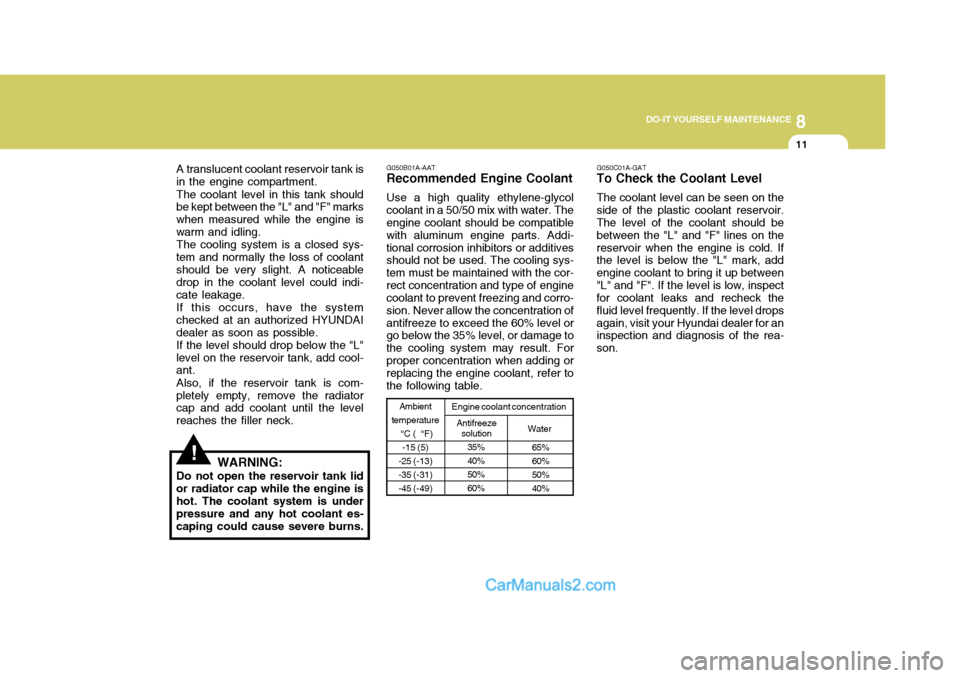
8
DO-IT YOURSELF MAINTENANCE
11
A translucent coolant reservoir tank is
in the engine compartment.
The coolant level in this tank should
be kept between the "L" and "F" marks when measured while the engine iswarm and idling.
The cooling system is a closed sys-
tem and normally the loss of coolant should be very slight. A noticeable drop in the coolant level could indi-cate leakage. If this occurs, have the system
checked at an authorized HYUNDAIdealer as soon as possible. If the level should drop below the "L"
level on the reservoir tank, add cool- ant.
Also, if the reservoir tank is com-
pletely empty, remove the radiatorcap and add coolant until the level reaches the filler neck.
!WARNING:
Do not open the reservoir tank lid
or radiator cap while the engine is hot. The coolant system is under pressure and any hot coolant es-caping could cause severe burns. G050B01A-AAT Recommended Engine Coolant Use a high quality ethylene-glycol coolant in a 50/50 mix with water. The engine coolant should be compatible with aluminum engine parts. Addi-tional corrosion inhibitors or additives should not be used. The cooling sys- tem must be maintained with the cor-rect concentration and type of engine coolant to prevent freezing and corro- sion. Never allow the concentration ofantifreeze to exceed the 60% level or go below the 35% level, or damage to the cooling system may result. Forproper concentration when adding or replacing the engine coolant, refer to the following table.
Water
65% 60%50%40%
35%40%50%60%
Ambient
temperature °C ( °F)-15 (5)
-25 (-13) -35 (-31)-45 (-49) Engine coolant concentration
Antifreezesolution G050C01A-GAT To Check the Coolant Level The coolant level can be seen on the side of the plastic coolant reservoir. The level of the coolant should be between the "L" and "F" lines on thereservoir when the engine is cold. If the level is below the "L" mark, add engine coolant to bring it up between"L" and "F". If the level is low, inspect for coolant leaks and recheck the fluid level frequently. If the level dropsagain, visit your Hyundai dealer for an inspection and diagnosis of the rea- son.
Page 181 of 205
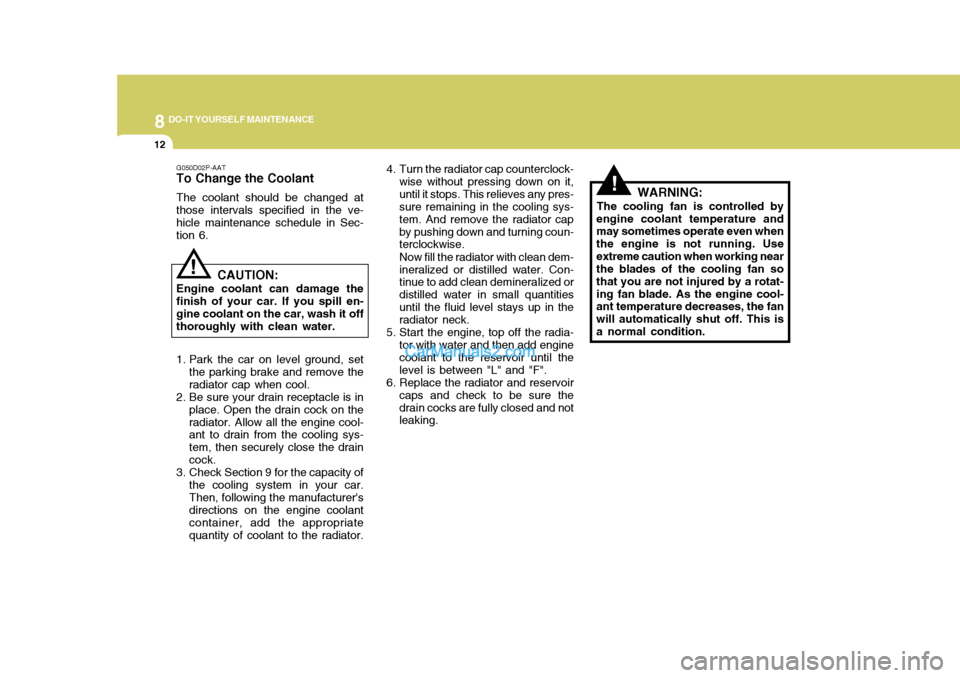
8DO-IT YOURSELF MAINTENANCE
12
!
4. Turn the radiator cap counterclock-
wise without pressing down on it, until it stops. This relieves any pres- sure remaining in the cooling sys- tem. And remove the radiator capby pushing down and turning coun- terclockwise. Now fill the radiator with clean dem- ineralized or distilled water. Con- tinue to add clean demineralized or distilled water in small quantitiesuntil the fluid level stays up in the radiator neck.
5. Start the engine, top off the radia- tor with water and then add engine coolant to the reservoir until thelevel is between "L" and "F".
6. Replace the radiator and reservoir caps and check to be sure thedrain cocks are fully closed and not leaking. WARNING:
The cooling fan is controlled by
engine coolant temperature andmay sometimes operate even when the engine is not running. Useextreme caution when working near the blades of the cooling fan so that you are not injured by a rotat-ing fan blade. As the engine cool- ant temperature decreases, the fan will automatically shut off. This isa normal condition.
G050D02P-AAT To Change the Coolant The coolant should be changed at those intervals specified in the ve- hicle maintenance schedule in Sec- tion 6.
!
CAUTION:
Engine coolant can damage the finish of your car. If you spill en-gine coolant on the car, wash it off thoroughly with clean water.
1. Park the car on level ground, set the parking brake and remove the radiator cap when cool.
2. Be sure your drain receptacle is in
place. Open the drain cock on theradiator. Allow all the engine cool- ant to drain from the cooling sys- tem, then securely close the draincock.
3. Check Section 9 for the capacity of the cooling system in your car.Then, following the manufacturer's directions on the engine coolant container, add the appropriatequantity of coolant to the radiator.
Page 188 of 205
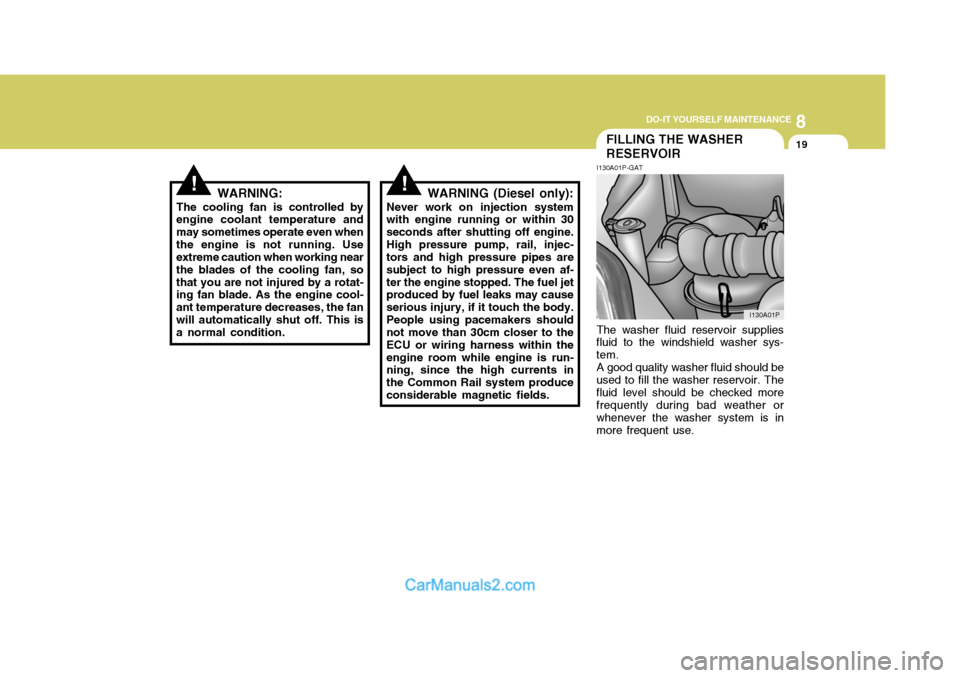
8
DO-IT YOURSELF MAINTENANCE
19
!WARNING:
The cooling fan is controlled by
engine coolant temperature and may sometimes operate even whenthe engine is not running. Use extreme caution when working near the blades of the cooling fan, sothat you are not injured by a rotat- ing fan blade. As the engine cool- ant temperature decreases, the fanwill automatically shut off. This is a normal condition.
FILLING THE WASHER RESERVOIR
I130A01P-GAT The washer fluid reservoir supplies
fluid to the windshield washer sys- tem.
A good quality washer fluid should be
used to fill the washer reservoir. Thefluid level should be checked more frequently during bad weather or whenever the washer system is inmore frequent use.
!WARNING (Diesel only):
Never work on injection system with engine running or within 30 seconds after shutting off engine.High pressure pump, rail, injec- tors and high pressure pipes are subject to high pressure even af-ter the engine stopped. The fuel jet produced by fuel leaks may cause serious injury, if it touch the body.People using pacemakers should not move than 30cm closer to the ECU or wiring harness within theengine room while engine is run- ning, since the high currents in the Common Rail system produceconsiderable magnetic fields. I130A01P